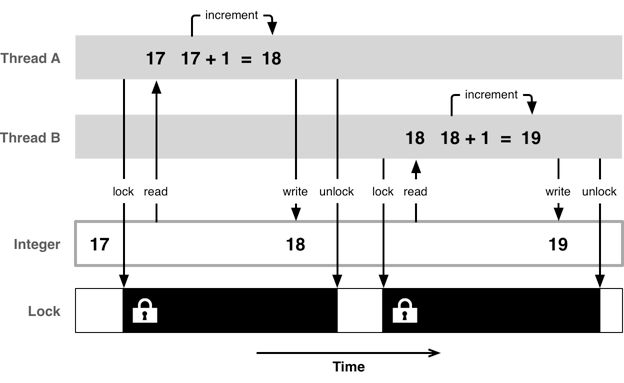细数iOS中的线程同步方案(一)
细数iOS中的线程同步方案(二)
多线程安全问题
多个线程可能访问同一块资源,比如同一个文件,同一个对象,同一个变量等;当多个线程访问同一资源时,容易引发数据错乱和数据安全问题;
如下面这个经典图所示,线程A、B均访问了Integer变量,但最终的结果(18)可能并不是我们想要的(19);
如果要保证共享的数据是正确的安全的,就需要使用线程同步技术:让多个线程间按顺序执行而不是并发执行;常见的线程同步技术就是加锁,同上面例子一样,加锁后能保证最终结果是正常的;
iOS中的线程同步方案常见的有以下几种:
- pthread相关方案
- OSSpinLock
- os_unfair_lock
- GCD相关方案
- NSOperationQueue相关方案
- NSLock
- NSRecursiveLock
- NSCondition
- NSConditionLock
- @synchronized
pthread相关方案
pthread是跨平台的,而且更加底层;我们先来了解pthread相关的锁;
PTHREAD_MUTEX_NORMAL 普通互斥锁
互斥锁的机制:被这个锁保护的临界区就只允许一个线程进入,其它线程如果没有获得锁权限,那就只能在外面等着;等待锁的线程会处于休眠状态,处于休眠状态不会占用CPU资源;
pthread_mutex的使用:
// 两种初始化方式
// 1.静态初始化
static pthread_mutex_t lock = PTHREAD_MUTEX_INITIALIZER;
// 2.动态创建
pthread_mutex_t lock1;
pthread_mutex_init(&lock1, NULL); // 可以根据需要配置pthread_mutexattr NULL默认为互斥锁
NSOperationQueue *queue = [[NSOperationQueue alloc] init];
[queue addOperationWithBlock:^{
pthread_mutex_lock(&lock); // 加锁
NSLog(@"%@===write===start",[NSThread currentThread]);
sleep(3);
NSLog(@"%@===write===end",[NSThread currentThread]);
pthread_mutex_unlock(&lock); // 解锁
}];
[queue addOperationWithBlock:^{
pthread_mutex_lock(&lock);
NSLog(@"%@===read===start",[NSThread currentThread]);
sleep(2);
NSLog(@"%@===read===end",[NSThread currentThread]);
pthread_mutex_unlock(&lock);
}];
两个线程任务同步执行:
{number = 5, name = (null)}===write===start
{number = 5, name = (null)}===write===end
{number = 6, name = (null)}===read===start
{number = 6, name = (null)}===read===end
// 或
{number = 8, name = (null)}===read===start
{number = 8, name = (null)}===read===end
{number = 7, name = (null)}===write===start
{number = 7, name = (null)}===write===end
PTHREAD_MUTEX_RECURSIVE 递归锁
顾名思义,递归锁用于递归调用加锁的情况;对于递归调用的加锁,如果使用上面normal锁,则会出现死锁;递归锁就是保证了对同一把锁能多次加锁,而不用等待解锁,从而避免了递归造成的死锁问题;
- (void)synchronizedTest {
pthread_mutexattr_t att;
pthread_mutexattr_init(&att);
pthread_mutexattr_settype(&att, PTHREAD_MUTEX_RECURSIVE); // PTHREAD_MUTEX_NORMAL普通互斥锁 PTHREAD_MUTEX_RECURSIVE递归锁
pthread_mutex_init(&_lock, &att);
pthread_mutexattr_destroy(&att);
NSOperationQueue *queue = [[NSOperationQueue alloc] init];
[queue addOperationWithBlock:^{
[self recursiveTest:3]; // 递归调用
}];
}
// 递归方法
- (void)recursiveTest:(NSInteger)value {
pthread_mutex_lock(&_lock);
if (value > 0) {
NSLog(@"%@===start",[NSThread currentThread]);
sleep(1);
NSLog(@"%@===end",[NSThread currentThread]);
[self recursiveTest:value-1];
}
pthread_mutex_unlock(&_lock);
}
输出正确的结果:
{number = 3, name = (null)}===start
{number = 3, name = (null)}===end
{number = 3, name = (null)}===start
{number = 3, name = (null)}===end
{number = 3, name = (null)}===start
{number = 3, name = (null)}===end
pthread_rwlock 读写锁
以上锁能很好的解决线程安全问题,但是这样的话同一时间,只会有一个线程能执行;有时我们的需求并不希望这样,比如读写操作:我们希望读是不受同步机制限制,即允许多个线程同时读;对于写,我们希望同一时间只允许一个线程操作;同时,在写操作进行时不允许同时读;而读写锁就是为这种场景而生的:
pthread_rwlock 读写锁与基本的互斥锁的创建使用方式大同小异:
// 两种初始化方式
// 1.静态初始化
static pthread_rwlock_t lock = PTHREAD_RWLOCK_INITIALIZER;
// 2.动态创建
static pthread_rwlock_t lock1;
pthread_rwlock_init(&lock1, NULL);
NSOperationQueue *queue = [[NSOperationQueue alloc] init];
for (int i = 0; i < 3; i ++) {
[queue addOperationWithBlock:^{
pthread_rwlock_wrlock(&lock);
NSLog(@"%@===write===start",[NSThread currentThread]);
sleep(3);
NSLog(@"%@===write===end",[NSThread currentThread]);
pthread_rwlock_unlock(&lock);
}];
}
for (int i = 0; i < 3; i ++) {
[queue addOperationWithBlock:^{
pthread_rwlock_rdlock(&lock);
NSLog(@"%@===read===start",[NSThread currentThread]);
sleep(2);
NSLog(@"%@===read===end",[NSThread currentThread]);
pthread_rwlock_unlock(&lock);
}];
}
结果中多个read是可以并发的,write是同步执行的;
{number = 5, name = (null)}===write===start
{number = 5, name = (null)}===write===end
{number = 6, name = (null)}===write===start
{number = 6, name = (null)}===write===end
{number = 4, name = (null)}===write===start
{number = 4, name = (null)}===write===end
{number = 3, name = (null)}===read===start
{number = 7, name = (null)}===read===start
{number = 8, name = (null)}===read===start
{number = 8, name = (null)}===read===end
{number = 3, name = (null)}===read===end
{number = 7, name = (null)}===read===end
pthread_join
使用场景:有A,B两个线程,B线程在做某些事情之前,必须要等待A线程把事情做完,然后才能接着做下去。这时候就可以用join。
static pthread_t thread1;
static pthread_t thread2;
void * writeFunc(void *args) {
NSLog(@"%u===write===start",(unsigned int)pthread_self());
sleep(3);
NSLog(@"%u===write===end",(unsigned int)pthread_self());
pthread_exit(NULL);
return NULL;
}
void* readFunc(void *args) {
pthread_join(thread1, NULL);
NSLog(@"%u===read===start",(unsigned int)pthread_self());
sleep(2);
NSLog(@"%u===read===end",(unsigned int)pthread_self());
return NULL;
}
- (void)synchronizedTest {
pthread_create(&thread1, NULL, writeFunc, NULL);
pthread_create(&thread2, NULL, readFunc, NULL);
}
这样就保证了read一定是在write后
871015936===write===start
871015936===write===end
871589376===read===start
871589376===read===end
pthread_cond 条件锁
条件锁能在合适的时候唤醒正在等待的线程。具体什么时候合适由程序员自己控制条件变量决定;
具体的场景就是:
B线程和A线程之间有合作关系,当A线程完操作前,B线程会等待。当A线程完成后,需要让B线程知道,然后B线程从等待状态中被唤醒,然后处理自己的任务。
// 1.静态初始化
static pthread_cond_t cond_lock = PTHREAD_COND_INITIALIZER;
static pthread_mutex_t mutex_lock = PTHREAD_MUTEX_INITIALIZER; // 需要配合mutex互斥锁使用
// 2.动态创建
static pthread_cond_t cond_lock1;
pthread_cond_init(&cond_lock1, NULL);
NSOperationQueue *queue = [[NSOperationQueue alloc] init];
[queue addOperationWithBlock:^{
pthread_mutex_lock(&mutex_lock);
while (self.condition_value <= 0) { // 条件成立则暂时解锁并等待
pthread_cond_wait(&cond_lock, &mutex_lock);
}
NSLog(@"%@===read===start",[NSThread currentThread]);
sleep(2);
NSLog(@"%@===read===end",[NSThread currentThread]);
pthread_mutex_unlock(&mutex_lock);
}];
[queue addOperationWithBlock:^{
pthread_mutex_lock(&mutex_lock);
NSLog(@"%@===write===start",[NSThread currentThread]);
sleep(3);
self.condition_value = 1; // 一定要更改条件 否则上面read线程条件成立又会wait
NSLog(@"%@===write===end",[NSThread currentThread]);
pthread_cond_signal(&cond_lock); // 传递信号给等待的线程 而且是在解锁前
// pthread_cond_broadcast(pthread_cond_t * _Nonnull) // 通知所有线程
pthread_mutex_unlock(&mutex_lock);
}];
{number = 3, name = (null)}===write===start
{number = 3, name = (null)}===write===end
{number = 4, name = (null)}===read===start
{number = 4, name = (null)}===read===end
这里有几个需要注意的地方:
- 一定要配合互斥锁使用;
- 一定要判断条件并更改条件;
- 最好使用while做条件判断(而不是if)
- 发送信号时,最好在临近区内发送(即互斥锁范围内);
以上几点的原因,可以参考下面大神的文章;
semaphore 信号量
信号量维护了一个unsigned int类型的value,通过这个值控制线程同步;具体有以下使用场景:
- 信号量的初始值设为1,代表同时只允许1条线程访问资源,保证线程同步
// 创建 原型sem_t *sem_open(const char *name,int oflag,mode_t mode,unsigned int value);
// name 信号的外部名字
// oflag 选择创建或打开一个现有的信号灯
// mode 权限位
// value 信号初始值
sem_t * sem = sem_open("semname", O_CREAT, 0644, 1);
NSOperationQueue *queue = [[NSOperationQueue alloc] init];
[queue addOperationWithBlock:^{
sem_wait(sem); // 首先判断信号量value 如果=0则等待,否则value-1并正常往下走
NSLog(@"%@===write===start",[NSThread currentThread]);
sleep(3);
NSLog(@"%@===write===end",[NSThread currentThread]);
sem_post(sem); // 执行完发送信号,value+1
}];
[queue addOperationWithBlock:^{
sem_wait(sem);
NSLog(@"%@===read===start",[NSThread currentThread]);
sleep(2);
NSLog(@"%@===read===end",[NSThread currentThread]);
sem_post(sem);
}];
- 信号量的初始值value,可以用来控制线程并发访问的最大数量
sem_t *sem = sem_open("semname_count", O_CREAT, 0644, 3);
NSOperationQueue *queue = [[NSOperationQueue alloc] init];
for (int i = 0; i < 21; i ++) {
[queue addOperationWithBlock:^{
sem_wait(sem);
NSLog(@"%@===write===start",[NSThread currentThread]);
sleep(2);
NSLog(@"%@===write===end",[NSThread currentThread]);
sem_post(sem);
}];
}
输出结果可以看出最多最会有3个线程:
{number = 6, name = (null)}===write===start
{number = 5, name = (null)}===write===start
{number = 7, name = (null)}===write===start
{number = 5, name = (null)}===write===end
{number = 5, name = (null)}===write===start
{number = 6, name = (null)}===write===end
{number = 6, name = (null)}===write===start
以上代码,其实就类似设置NSOperationQueue的maxConcurrentOperationCount效果;
NSOperationQueue *queue = [[NSOperationQueue alloc] init];
queue.maxConcurrentOperationCount = 3;
OSSpinLock自旋锁
自旋锁的作用同互斥锁一样,不同于互斥锁的线程休眠机制,自旋锁等待的线程会忙等,也就是等待的过程其实是在跑一个while循环;这样等待的过程同样消耗CPU资源,但这种方式不会涉及线程唤醒、休眠的切换,性能会高点;
__block OSSpinLock lock = OS_SPINLOCK_INIT;
NSOperationQueue *queue = [[NSOperationQueue alloc] init];
[queue addOperationWithBlock:^{
OSSpinLockLock(&lock);
NSLog(@"%@===write===start",[NSThread currentThread]);
sleep(3);
NSLog(@"%@===write===end",[NSThread currentThread]);
OSSpinLockUnlock(&lock);
}];
[queue addOperationWithBlock:^{
OSSpinLockLock(&lock);
NSLog(@"%@===read===start",[NSThread currentThread]);
sleep(2);
NSLog(@"%@===read===end",[NSThread currentThread]);
OSSpinLockUnlock(&lock);
}];
同样能同步执行,但代码会有警告:
'OSSpinLockUnlock' is deprecated: first deprecated in iOS 10.0 - Use os_unfair_lock_unlock() from
instead
这是因为OSSpinLock已经不再安全了,会有优先级反转问题;
多线程并发处理,原理上说是CPU时间片轮转机制,即将时间划分为极小单位,每个线程依次执行这极段的时间;这样多个线程看起来是同时执行的;另外,不同的线程有可能是不同的优先级;高优先级的线程要占用较长的时间、CPU资源;高优先级线程始终会在低优先级线程前执行,一个线程不会受到比它更低优先级线程的干扰。
如果使用自旋锁,且一个低优先级的线程先于高优先级的线程获得锁并访问共享资源;同时高优先级的线程也会尝试获取锁,获取锁失败就一直忙等,忙等状态占用大量CPU资源;而低优先级的线程也需要CPU资源,但是竞争不过从而导致任务迟迟完不成,无法解锁;
苹果给的建议是使用os_unfair_lock替代,但这个最低只支持iOS10;
__block os_unfair_lock lock = OS_UNFAIR_LOCK_INIT; // 初始化
os_unfair_lock_lock(&lock); // 加锁
os_unfair_lock_unlock(&lock); // 解锁
参考:
pthread的各种同步机制
不再安全的 OSSpinLock

